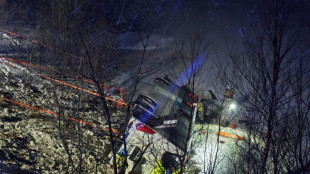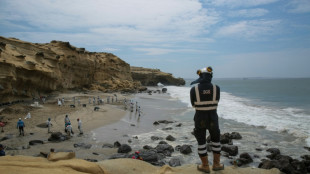
-
 Smith century puts Australia in control of 4th Test against India
Smith century puts Australia in control of 4th Test against India
-
Israeli strikes hit Yemen as Netanyahu fires warning

-
 Peru ex-official denies running Congress prostitution ring
Peru ex-official denies running Congress prostitution ring
-
Australia's Smith reaches 34th Test century

-
 NHL Red Wings fire Lalonde and name McLellan as head coach
NHL Red Wings fire Lalonde and name McLellan as head coach
-
Injured Halep withdraws from Australian Open

-
 Liverpool power seven points clear, Man Utd crash at Wolves
Liverpool power seven points clear, Man Utd crash at Wolves
-
Leaders Liverpool survive Leicester scare to go seven points clear

-
 Membership of UK's anti-immigration Reform party surpasses Conservatives
Membership of UK's anti-immigration Reform party surpasses Conservatives
-
Two dead in treacherous Sydney-Hobart yacht race

-
 Amorim warns of 'long journey' ahead for miserable Man Utd
Amorim warns of 'long journey' ahead for miserable Man Utd
-
Three dead, four injured in Norway bus accident

-
 Man Utd fall to Wolves as Fernandes sees red
Man Utd fall to Wolves as Fernandes sees red
-
Fernandes sent off as Man Utd crash at Wolves, troubled Man City held by Everton

-
 'Logical' that fatigued Spurs are faltering - Postecoglou
'Logical' that fatigued Spurs are faltering - Postecoglou
-
Manmohan Singh: technocrat who became India's accidental PM

-
 India's former PM Manmohan Singh dies aged 92
India's former PM Manmohan Singh dies aged 92
-
Acid risk contained in deadly Brazil bridge collapse

-
 Chelsea stunned by Fulham in blow to Premier League title hopes
Chelsea stunned by Fulham in blow to Premier League title hopes
-
Troubled Man City held by lowly Everton, Chelsea title bid rocked

-
 Paterson, Bosch give South Africa edge over Pakistan in first Test
Paterson, Bosch give South Africa edge over Pakistan in first Test
-
Oil leak in Peru tourist zone triggers 'environmental emergency'

-
 Mozambique post-election violence kills 125 in three days: NGO
Mozambique post-election violence kills 125 in three days: NGO
-
Finns probing ship from Russia for 'sabotage' of cables

-
 Williams hits unbeaten 145 as Zimbabwe make Afghanistan toil
Williams hits unbeaten 145 as Zimbabwe make Afghanistan toil
-
Bowlers bring Pakistan back into first Test in South Africa

-
 Banbridge foils French to land King George VI Chase for Ireland
Banbridge foils French to land King George VI Chase for Ireland
-
Man City pay penalty for Haaland miss in Everton draw

-
 Paterson takes five wickets as Pakistan bowled out for 211
Paterson takes five wickets as Pakistan bowled out for 211
-
Kremlin cautions on 'hypotheses' over plane crash

-
 Pakistan military convicts 60 more civilians of pro-Khan unrest
Pakistan military convicts 60 more civilians of pro-Khan unrest
-
Turkey lowers interest rate to 47.5 percent

-
 Syria authorities launch operation in Assad stronghold
Syria authorities launch operation in Assad stronghold
-
Record number of migrants lost at sea bound for Spain in 2024: NGO

-
 Kohli called out over shoulder bump with Konstas during fourth Test
Kohli called out over shoulder bump with Konstas during fourth Test
-
Rural communities urged to flee east Australia bushfire

-
 Sri Lanka train memorial honours tsunami tragedy
Sri Lanka train memorial honours tsunami tragedy
-
S. Korea's opposition moves to impeach acting president

-
 'We couldn't find their bodies': Indonesian tsunami survivors mourn the dead
'We couldn't find their bodies': Indonesian tsunami survivors mourn the dead
-
Lakers pip Warriors after another LeBron-Curry classic

-
 India readies for 400 million pilgrims at mammoth festival
India readies for 400 million pilgrims at mammoth festival
-
Nepal hosts hot air balloon festival

-
 Asia stocks up as 'Santa Rally' persists
Asia stocks up as 'Santa Rally' persists
-
Tears, prayers as Asia mourns tsunami dead 20 years on

-
 Sydney-Hobart yacht crews set off on gale-threatened race
Sydney-Hobart yacht crews set off on gale-threatened race
-
Key public service makes quiet return in Gaza

-
 Fearless Konstas slams 60 as Australia take upper hand against India
Fearless Konstas slams 60 as Australia take upper hand against India
-
Hungry Sabalenka ready for more Slam success

-
 Mass jailbreak in Mozambique amid post-election unrest
Mass jailbreak in Mozambique amid post-election unrest
-
Bridges outduels Wembanyama as Knicks beat Spurs


Bison reintroduced to Canada's Banff thrive again
Wild bison that once numbered in the tens of millions in North America before being hunted almost to extinction are once again thriving in a pocket of western Canada.
Appearing from a distance as specks against the backdrop of the Rocky Mountains, these animals are also restoring balance at the top of a fragile ecosystem.
North America's largest land mammal -- growing to 900 kilograms (2,000 pounds) and 1.8 meters (six feet) high at the shoulders -- suffered a dramatic decline in late 19th century due to hunting and habitat loss as settlers pushed westward.
They were reintroduced to what is now Banff National Park in 2017.
"The moment the bison set foot on that landscape, it felt to me that I brought them home," says Wes Olson, who accompanied the first 16 bison to be released there.
Transferred by helicopter from a biosphere reserve near Edmonton, Alberta, the population has exploded and new births are expected to push their numbers to 100 by year's end.
A Parks Canada report published this week concluded that the reintroduction was a success, and it suggested that due to their robust growth rate, this bison subpopulation -- one of only five that occupy a mere 0.5 percent of their original range in North America -- may no longer be considered endangered within a decade.
As soon as they arrived, Olson says, the ancient ecosystem was suddenly reactivated and the bison appeared to feel right at home, while other forest creatures quickly and "intrinsically" reestablished a symbiotic relationship.
Squirrels with puffy cheeks can be seen busily collecting hairs shed by the burly beasts, says the 69-year-old former park warden.
One hundreds species of insects colonize its nutrient-rich dung.
Birds also get in on the action. They take turns sitting on bisons' backs and plucking bits of fur to make nests, as well as bugs or seeds trapped in it to eat. Warmer and more comfortable fur-lined nests lead to better outcomes for the chicks.
- Great Plains 'landscape engineers' -
A "keystone species" of the Great Plains, a broad expanse of flatlands that stretch across 13 Canadian provinces and US states, from Alberta to Texas, wild bison, by way of their grazing, have shaped this environment.
These "landscape engineers" are on the move as they graze rather than focus on the same patch of land, with their role somewhat like that of elephants in Africa, explains Marie-Eve Marchand of the International Buffalo Relations Institute.
And with herds mobile like that, grasslands are able to regenerate and better store carbon and water, according to a study by the University of Alberta. Other studies also found that the presence of bison makes them more resilient to drought.
Between 30 and 60 million bison once roamed North America. At the end of the 19th century, there were only a few hundred left.
Their decline had a devastating impact also on Indigenous tribes that relied on the animals for food, as well as clothing, shelter and religious worship.
Their return to Banff, an ancestral gathering place of local tribes, has helped revive "parts of our language, culture and deep, deep spirituality that the first peoples of this place had with the land," says Marchand.
- Indigenous future includes bison -
"At one point," says Violet Meguinis of the Tsuut'ina First Nation of southern Alberta, "bison was our main source of food."
"Bringing them back and releasing them in the wild is significant for us," she says.
Several Indigenous communities have been working in recent years to reintroduce bison to their ancestral lands and are eager to do more, including the Tsuut'ina, which started by raising a domestic herd of 400 bison about 100 kilometers (60 miles) east of Banff.
Clayton Whitney has cared for the animals for eight years, helping to "bring them back from extinction," work that he considers to be a privilege given how important bison are to the community.
The tribe comes together to butcher a few each year for their meat and hides as their ancestors did, while the simple act of moving the herd from paddock to paddock to mimic their movements in the wild has stirred growth of plants used for Indigenous traditional medicines, he says.
The entire community takes part in the ritual slaughter, with elders passing on their knowledge of how to properly skin the animal, and leave none of it to waste.
"We depend on (the bison) as much as it depends on us," says Meguinis.
"We want this land to be there for them, we want the bison to be here because then that preserves our own future," she sums up.
H.Silva--PC



